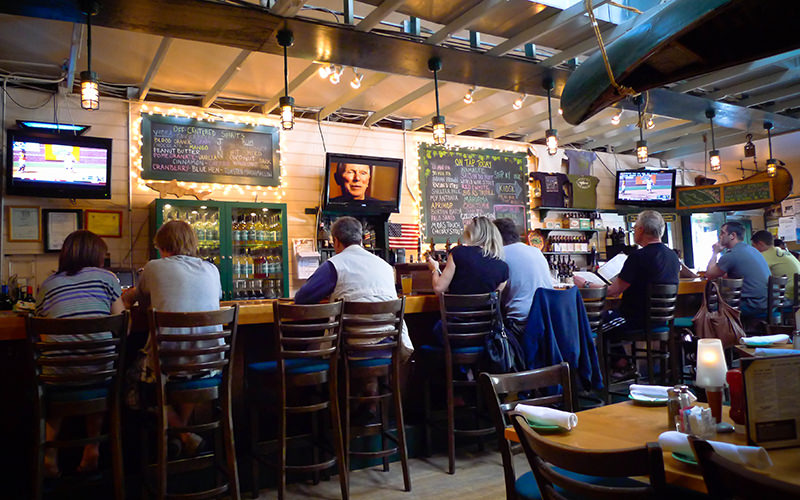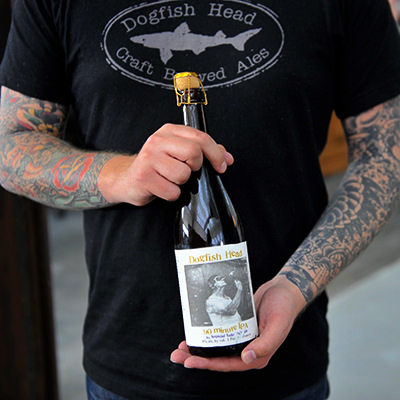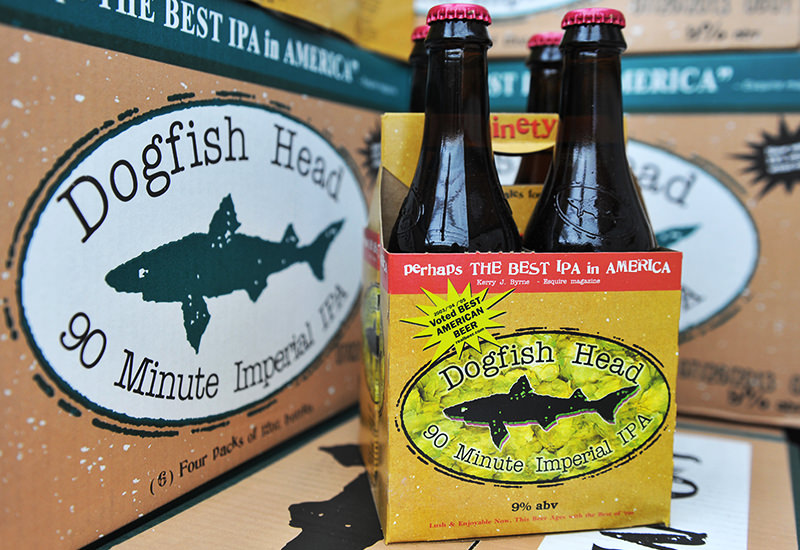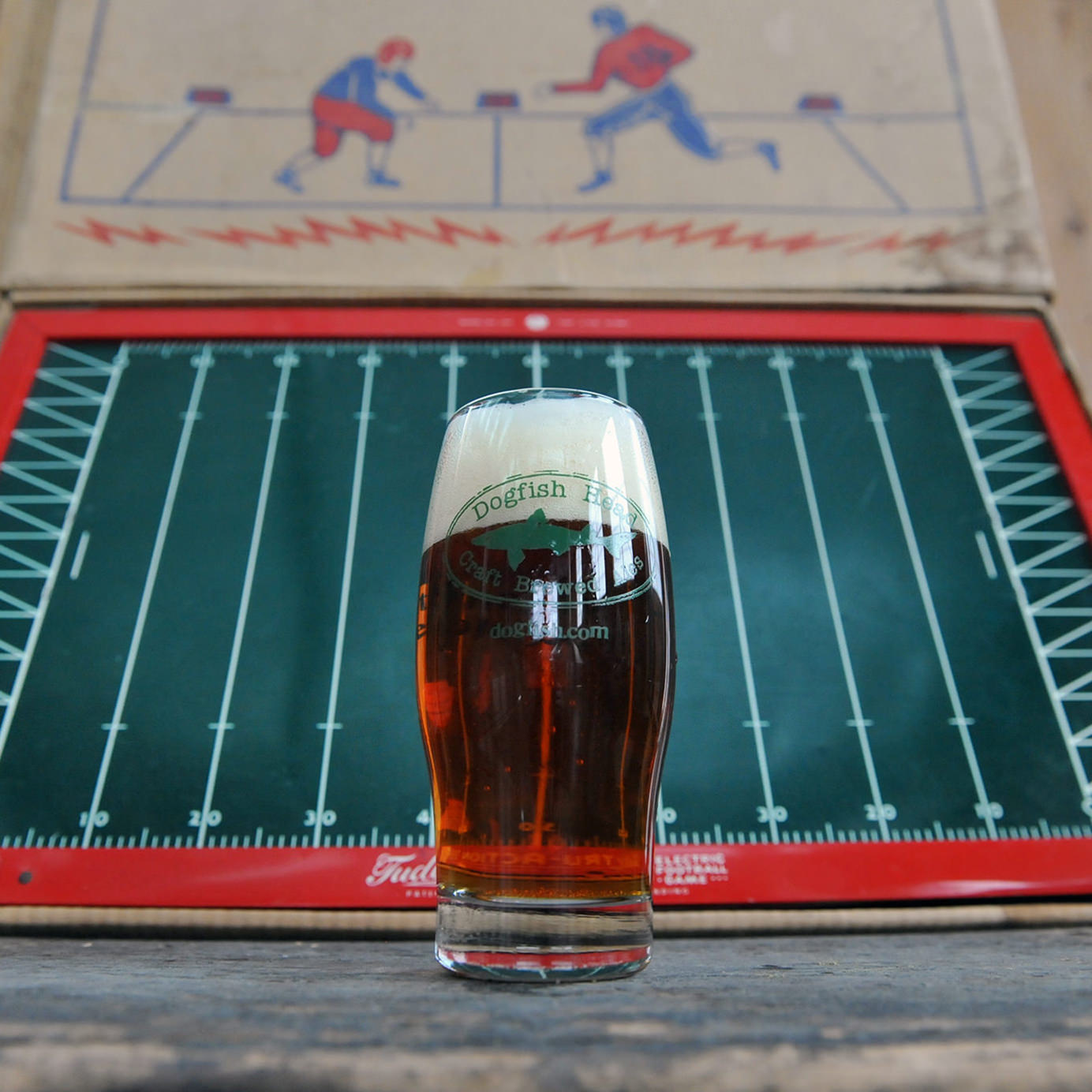Whether you’re a fan of craft or macro beer, it’s incredibly likely you’re familiar with Dogfish Head and its innovative founder Sam Calagione. What began in 1995 as a small brewpub in Delaware has mushroomed into one of the largest craft beer brands in the world – a banner carrier for the craft movement that continues to explode. And if you are a fan of craft beer, there is no doubt that you’ve had one of Dogfish Head’s beers and in all likelihood that beer was 90 Minute IPA.
While IPA is not the only style that defines the brewery, the brewery helped define the style, creating the first ever continuously hopped IPA and setting the standard that would be followed by countless breweries to come while also bringing to life the entire Imperial IPA category.
This IPA movement started with 90 Minute, the first in the brewery’s series of continuously hopped IPAs that would come to define Dogfish Head’s innovative style of beers, and that journey began with a cooking show, a spark and an old school tabletop vibrating football game. So we sat down with Sam and his wife and Vice President of Marketing, Mariah, to get the full story of how 90 Minute IPA came to be.
Don't Miss A Drop
Get the latest in beer, wine, and cocktail culture sent straight to your inbox.This is the oral history of 90 Minute IPA.
Sam: I opened Dogfish Head in ‘95 with the goal of brewing off centered and innovative beers. The first beers we opened with were a Chicory Stout and an Immort Ale that was made with maple syrup and vanilla beans, so it was always in our DNA to try and push the category of beer forward. After a year of being open we started playing a bit with hops; I created Aprihop, a fruit infused IPA and our Indian Brown Ale, which was basically a dark IPA. These were pretty much our hoppy beers for about two or three years.
VinePair: So at this point IPA wasn’t really the primary focus?
Sam: Exactly. I wanted to make an intensely hoppy beer, but the problem was if you were to add a bunch of hops in the traditional two stages of the brewing process – in the beginning for bitterness and at the end for aroma – you would wind up with what is a very bitter beer that’s completely overwhelming. That wasn’t the kind of beer I wanted to make, so I kept experimenting in other areas instead. You have to remember, in the late 90’s IPA wasn’t the behemoth of a category that it is today, so there wasn’t the demand you now see where no matter what tasting room or beer bar you’re in, there has to be an IPA on tap simply because the public demands it.

However, in 1999 I was watching a cooking show on TV and that’s when I had the spark of how to pull off an incredibly hoppy IPA without the overwhelming bitterness. The chef was talking about making a soup and he said he liked to add pinches of crushed peppercorn the entire time during the cooking process while the soup simmered because he had found that by adding little increments of pepper over an extended period of time the flavor would come forward with more complexity and subtlety than if he had dumped the pepper in all at once. I figured it was worth a shot trying the same technique with hops.
The problem was, I needed to figure out how to pull off the same idea of continuously adding hops in the same way the chef had continuously added pepper in a controlled way that didn’t mean standing over the brew kettle the entire time.
VinePair: So was there a lot of experimentation done before you came to the conclusion of how you’d pull it off?
Sam: Honestly, this was a first time’s the charm, third time’s the trainwreck type situation. I was driving by a Salvation Army out on the highway and I decided to stop. While perusing the store I came across one of those old vibrating football games. For whatever reason I immediately thought this could be the answer, so I bought the game and headed back to the brewery. We duck tapped the game to a ladder so that it would hang over the caldron of boiling beer and turned it on. Sure enough, the vibrations caused the pellets to vibrate down the game and drop into the beer a few at a time over the course of the 90 minute boil, continuously hopping the beer just as I had seen the chef continuously add pepper to his soup, and that’s how 90 Minute IPA was born.
I say the third time is the trainwreck, though, because by the third time we brewed the beer this way, the football game was too old to handle the heat and steam it was subjected to by being placed over the caldron and the motor got wet and broke. But by then the theory of continual hopping was proven. By dosing tiny bits of hops continually in equal increments over the whole boil you can make a beer that’s intensely hoppy without being brutally bitter.
The result was a beer that was 9% alcohol and 90 IBUs. We loved it at the brewery, but I wasn’t really sure other people would go for it. You have to remember that IPAs made in 1999 weren’t the hot style and there definitely weren’t people out there searching for the next great IPA. I really didn’t think a lot of people were going to drink it.
Mariah: Yeah, I would even say that internally some of us took a while to come around to it. Some people thought it was awesome right off the bat, but those were the more hophead-focused people at Dogfish. But for some of us, and I would raise my hand in that camp, it was like this is bold and pretty big and enjoyable, but I don’t know if I would like a whole bottle of it.
Now, looking back, it almost seems compared to its peers 90 Minute kind of falls right in the middle of the pack when it comes to hop intensity, feeling much more mild than it did at the time, most likely because our palates have evolved as American IPAs have evolved.
Sam: At the same time we were brewing 90 Minute we were also developing Midas Touch, the strong beer made with honey and white Muscat grapes that came from chemical research from a 2,700-year-old tomb. It was more wine-like in its alcohol and its complexity and for whatever reason I was much more confident about it than 90 Minute.

Because Midas Touch was sort of like a wine, we built this packaging rig that would allow us to fill Midas Touch into Champagne style bottles but we needed to pay for the rig, so we figured why not bottle a few other beers in these large format bottles as well, to sort of make up for the slack. Since I thought there was no way 90 Minute would ever sell more than Midas Touch would sell we decided it would be one of the beers we used as filler to help us pay for the system.
So we took this intensely hoppy beer that we had made and bottled it in a corked Champagne bottle. For the label we took an old photo of a circus freak hammering a nail into his nose to symbolize just how intensely hoppy it was and sent the beer out to the marketplace, not knowing how it would be received.
Mariah: You have to remember this was 1999 when the internet was still pretty new, so you didn’t really get immediate feedback.
Sam: Yeah, I mean I didn’t even really have email. At around the same time Alan Newman, who was the founder and past president of Magic Hat Brewery, called me and said, “I really love what you guys are doing. You are doing all kinds of crazy exotic beers and fun events and stuff. I’d love to meet and drink beer with you up at this event in New England.” So I went to the event and we became friends and he was like “alright, let’s stay in touch by email” and I was like “what’s email?” So he was my first email buddy in ’98 or ’99.
Mariah: We sort of knew there were these beer forums online but the idea of marketing beer online would be a little bit of an overstep at that point.
Sam: Within months of sending 90 Minute out some of our distributors around the country started sending cases of the stuff back to our brewery because they said the beer was too hoppy, people thought it was gross, no one would drink 750ml of that hoppy of a beer, the label was offensive, and that kind of stuff. We couldn’t believe it. Yet at the same time, as we were taking cases of beer back, we started hearing reports of hard-core beer geeks trying to sneak 90 Minute out. Basically get their hands on it any way they could. We couldn’t figure out how they knew about it.
Mariah: And that’s how we found out about Beer Advocate.
Sam: We had a tiny little office in our house where we shared one family computer where Mariah mostly worked. I remember coming in the back door and she had a website up and she was like “Hey, I just got a request from these two brothers that run this website and they say 90 Minute IPA is the highest rated beer on it. The site is called Beer Advocate.” And I was like oh my god, these guys are going to try and make a living off a beer website? I want to talk to these guys. And now Jason and Todd Alström have become two of my best friends in the industry.
Mariah: So we had the buzz among the community of real craft beer obsessives, but it was the Esquire article that really caused the beer to take off. The magazine named 90 Minute America’s best IPA, and all of a sudden the beer went from zero to 100 in a hurry. With the growing demand we moved the beer from its large format bottles into 12-ounce vessels with the more traditional Dogfish label.
Sam: In that era, beers like our Raison d’Extra and our Chicory Stout were our best sellers but 90 Minute just took off. A lot of people think our 60 Minute was the IPA that put us on the map, but we didn’t even brew 60 Minute IPA until two or three years after we were brewing 90 Minute.
Mariah: It is still our second best selling beer right now. But you have to remember that even when it came out we were so much smaller in terms of production and it was still one of our best selling beers. Sam, do you remember the exact barrelage amount when we first started to put it into production in terms of 12-ounce beer rounds versus now?
Sam: In terms of scale, we started off probably brewing hundreds of barrels per quarter, 50-barrel batches once a month, to brewing thousands of barrels per quarter within a year or two.
That moment in time, 1999 to 2000, was the time when Mariah and I could start regularly cashing our paychecks. We opened in ’95 and our brewpub was very lucky; all of our food was cooked over a wood grill and it was very rustic and the beer we made was culinarily oriented and very inventive. But when we opened our separate production brewery in ‘96, and flagship beers were 11% alcohol and made with maple syrup and vanilla and aged on oak and coffee and chicory, we had a really hard time paying our bills. But we never dumbed down our beer or discounted our beer; we stayed true to our model. Then in ’99 when we started selling the Midas and 90 Minute it just created a shift northward in our trajectory. Our company has grown double digits every year since then.

Mariah: The 90 Minute, now with so many choices on the market, is still the beer we consistently get so much love for through social channels. Every day I see messages from people saying “oh my gosh I haven’t had this one in a while” or “Wow, I forgot how good this is.”
Sam: I think it’s important to note, though, that 90 Minute was not the first hop-forward beer, though we were the first to be called an Imperial IPA, at least according to my buddy Greg Koch of Stone Brewing who did the research. But seriously, think of how extreme something like Sierra Nevada Pale Ale tasted in 1980 when it came out with its Cascade forward hop profile. That was an extreme beer for 1980 and certainly for 1999, 90 Minute was an extreme beer.
But as Mariah has alluded to earlier, American palates in general have navigated a substantial threshold shift and the average craft beer drinker now has a higher tolerance for hop forward beers. But, I do think 90 Minute, with that balance between the complex mash bill, the different grains that we use in it, and our unique continual hopping approach, plus the centerpiece Palisade hops, which we focus our IPAs around, makes the beer really stand out in a world where there’s a new IPA coming to market every 90 minutes.
You will never see Dogfish say our beer is the best or say we think we make the best IPA in the world. Everybody’s palate is different, so the best is subjective, but I can proudly say that along with my 250 coworkers we make a world class IPA that stands shoulder to shoulder with the other breweries that make world class IPAs. We know what the IPA landscape looked like in America at the moment that we created 90 Minute and how monumental it was not only in that era but also today. I’m very proud of that.
This story has been edited and condensed for clarity.
